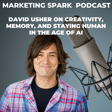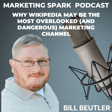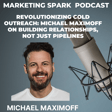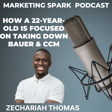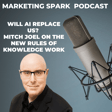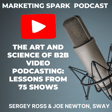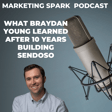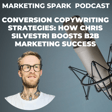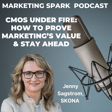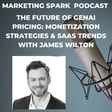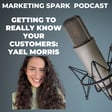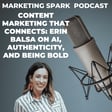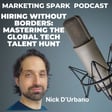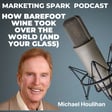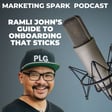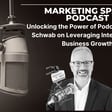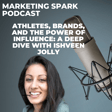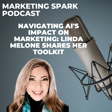Become a Creator today!Start creating today - Share your story with the world!
Start for free
00:00:00
00:00:01

It's Not Email Marketing. It's Engagement Farming
Too many brands leverage email marketing to drive sales. That's it.
But Coherent Path CEO James Glover contends that retailers should use email marketing to build stronger relationships and help consumers discover new opportunities, and, yes, drive sales.
He calls this approach "engagement farming". It's based on the idea that customers should look forward to getting email because it engages and deliver values. If they also buy something, that's great.
For more about James and this episode of Marketing Spark, check out the show notes.
Transcript
Introduction to 'Marketing Spark' Podcast
00:00:03
Speaker
My name is Mark Evans, and I'd like to welcome you to Marketing Spark, the podcast that delivers small doses of insight, tools, and tips from marketers and entrepreneurs in the trenches. By small doses, it's conversations that are 15 minutes or less.
Creating Effective Email Marketing Campaigns
00:00:17
Speaker
On today's show, we're going to talk about email and how to create campaigns that drive better results. I'm excited to have James Glover, CEO with Coherent Path,
00:00:25
Speaker
a SaaS platform that takes retailers content and distribute it as a diet through email to maximize customer engagement and lifetime value. Welcome to Marketing Spark. Thanks for having me on the show, Mark. Now,
Why Email Remains Dominant
00:00:36
Speaker
one of the things I wanted to ask you, James, is that email is still alive and well. There's all kinds of different ways to connect with customers, yet email never seems to die. I mean, people still embrace it. People still open email. How do you explain that?
00:00:52
Speaker
I think one of the ways to think about this is we're a data science company. We like to look at what data we have on hand in order to help with the conversation with your customers. When we look at the data, we see at GAP, for example, they might e-mail their customer something like five or 600 times a year. That same customer probably buys from the GAP four or five times a year and visits their website 10 or 12 times a year.
00:01:20
Speaker
When
Balancing Transactional and Engagement Emails
00:01:20
Speaker
you think about the email channel in that context, 500 of your 520 interactions with your customer, it's easy to understand why it's still viewed as one of the primary vehicles for communication that large brands have to reach their customer. It's also a channel where they can control the conversation.
00:01:41
Speaker
When the customer visits the website, they visit for a reason. Whereas when you decide to send out an email, you get to decide what to talk about. Of course, it's hugely important that that topic be relevant to the person that you're sending it to, but you get to decide what you want to talk about with the customer. I think that's another reason why email is still a great vehicle for building your brand and having a conversation with the customer.
00:02:04
Speaker
Now,
Combating Email Fatigue with Smart Strategies
00:02:04
Speaker
one of the things about email is we live in this world of marketing automation. I mean, marketers love these tools that allow them to do a little bit of work, but get maximum impact. And it has driven this whole idea of drip marketing, where you continue to hammer away at your, at your prospects and customers, uh, with all kinds of different offers and information, but.
00:02:26
Speaker
My sense is that there's there's email fatigue because after a while the drip marketing review isn't as effective because it's yet another email from a company to a prospect hoping they'll do something. How can companies take a smarter, better approach to email marketing and how does drip marketing fit into the scheme of things? I think part of it is you
00:02:48
Speaker
a lot of retailers that think of email kind of like an ATM machine. And when you get behind at the end of the quarter, how are you going to make up that revenue? Oh, send out another email. And if you're still behind, send out another email. And so what you're trying to do when you do that is leverage the people that are at the bottom of the funnel, the transaction funnel in order to get some revenue today.
00:03:15
Speaker
And that is certainly a reality for many retailers that that number is important and they use email in order to help them hit the number. What that scares though is that email is also the primary, like we said before, the primary vehicle for building your brand, for having a conversation with your customer.
00:03:37
Speaker
For
Conversions as Engagement Opportunities
00:03:37
Speaker
me, it kind of reminds me of when I read that book by Michael Pollan called The Omnivore's Dilemma and he went down and he met a farmer and the farmer sold chickens and eggs and rabbits and all kinds of different things. But he described himself to Michael Pollan as a grass farmer, that if he took care of the grass, which all of the animals eat, then, you know, he would always have a great farm that would continue to produce for many, many
00:04:03
Speaker
generations. And I kind of think of email marketing as engagement farming. You have the right to capture that customer at the bottom of the funnel because you've continued to engage them in a conversation. And so retailers need to think about using email to build their brand and to encourage customers to shop in new categories, to use it for
Balancing Promotional and Educational Content
00:04:29
Speaker
discovery of things that the customers never seen before. And in that respect, they should think of themselves as building engagement, as well as also doing the important sort of make the cash register ring in important moments.
00:04:42
Speaker
When I think about email is that there's conversions are often equated to sale. So if I send an email, I want somebody to buy something, but should conversions be looked at in different ways? So for example, should we as marketers and retailers look at email campaigns as opportunities to engage and educate?
00:05:03
Speaker
where the sale may not be the primary objective. I mean, at the end of the day, that's what you want people to do, but your, your emails have different, you're looking for them to deliver in different ways. Is that the way to look at, at conversions these days when it comes to email? If you think about sending out a hundred emails, you'd be excited if one person converted. And as I said, for the average retailer, you might see a frequency of four or five conversions per year.
00:05:32
Speaker
regardless of channel, let alone driven through the email channel. And so from the email channel, it might be one conversion a year. And so if you focus your 600 emails around trying to get that customer to convert exclusively on trying to get that customer to convert, pretending that they're always at the bottom of that conversion funnel, well, then you'll see an email diet that kind of looks like the American diet in the sense of
00:06:01
Speaker
being very rich in promotions and trying to take advantage of the buy right now sort of thing. As opposed to telling the story and building the brand and taking the opportunity
Machine Learning for Personalization
00:06:14
Speaker
Are to educate the customers hello being one of our customers said this customer is only bought shirts from us we're pretty sure they wear pants you know but if i use every email as an opportunity to try to sell them another shirt on a discount i'm gonna miss out on the chance of educating them about the pants in the socks in the shoes and all the other things.
00:06:32
Speaker
that I sell. And so we need to use the balance between, okay, this customer hasn't purchased in a while, a promotion might be a good tool to try to get them to, uh, to convert need to balance that with the reality that they're going to convert five or six times a year. And I'm going to get 500 at bats to talk to them. And I need to be as broad as possible in terms of, and still being relevant.
00:06:55
Speaker
for them in order to keep the relationship and keep them opening the emails at a sufficient rate. If they don't open an email for nine months or something like that, I don't get to continue the conversation.
00:07:08
Speaker
The other thing that I think about when it comes to email is the idea that a lot of companies embrace a one size fits all approach, or what they do is they do a little bit of segmentation based on customer personas. And they believe that is the way that they can deliver relevant content and offers. But what I'm wondering about is if, whether there's a better approach, whether we can use machine learning, for example, to deliver a
00:07:34
Speaker
personalized diet of content, as you say, content that is relevant to people's interests, their activities, what they they're buying behavior, all those other variables.
Scaling Personalized Content
00:07:45
Speaker
So that when you get an email from a company, you say to yourself, this is this is for me, they're there. It's aligned with who I am and what I do and what I like to buy. Is that kind of the promised land? Does it make customer personas and acronyms for that matter?
00:08:00
Speaker
When I think about this question, I kind of think of it in two respects and often I'm talking to a large retailer and they say to me, how do I get to kind of
00:08:10
Speaker
The stage where my program looks like some of the great programs that are out there. Your L Beans is a great example. How do I get my program to look like L Beans program? And I kind of break it down in two respects. And the first I sort of use the first one is like Slay the Dragon and the second one as Marry the Princess. If I can slay the dragon, I get to go back home and marry the prince. What do I mean by that? So, you know, there are lots of things that I'm doing that just simply don't scale.
00:08:38
Speaker
And so a lot of the reason why I'm not providing relevant content to my customers
00:08:44
Speaker
is because I can't scale to the place where LL Bean is sending out 5 million different versions of its email every day. How are they doing that? How do I scale to the place where I have the infrastructure to send out 5 million? Let alone knowing what each of those 5 million people want for dinner tonight. But how do I serve 5 million different meals to 5 million different customers? And that's about having a library of content that's available. It used to be that
00:09:13
Speaker
folks like Bloomingdale's or others of our customers would create an email today and they would send it out and then that email would die. Perfectly good investment
Automation and Email Personalization
00:09:23
Speaker
in creative and yet something that they would just let live for one day. Now they add it to a library that's building up over time. And so at any given time, there might be 200 or 300 options in the LL Bean or the Bloomingdale's library.
00:09:40
Speaker
That's about how do I get better use out of my creative in order to scale to the place where I can have a personalized, relevant conversation with the customer. Then there's the templates, standardizing the templates, making them ready for dynamic content. There's a lot of work that goes into the idea, if you thought about how would you QA five million different emails,
00:10:02
Speaker
Well, you'd have to standardize a bunch of different things and have templates that were ready for personalizing events. And so there's a lot of work that goes into the work that you would do with your email service provider in order to get you ready to be at a place where you could send 5 million different emails. And what
Post-Pandemic Email Strategies
00:10:19
Speaker
we found is that often, you know, when you're doing some segmentation and you're sending out six versions of the email in a relatively manual fashion,
00:10:29
Speaker
Going from six versions to 5 million versions, you're automating a ton of stuff that you used to do manually. And in fact, it's less labor. And so in this current economic climate, we see a lot of people driving towards automation as a way to reduce costs. And so if you can do that and put in an infrastructure that will enable you to send out 5 million different versions of the email with less labor, we call that slaying the dragon. Now you're ready.
00:10:59
Speaker
And then the Mary the princess is, okay, how do I get to take advantage of this infrastructure to kind of get my program to the place where I'm having a relevant conversation with each customer? And that's the machine learning that is required where you're taking in all of the different information that you're getting from each of your different channels. And you're thinking about it as a diet through time. What we found is that if you rely on segmentation
00:11:27
Speaker
you're very likely to over-represent some of your categories while neglecting others. A simple example of that, one of our retail partners, they would apply a label of women or men to each of their customers. And that seemed to make sense to them. But what we showed them was that if even with respect to gender, you approach it as a diet. So for this customer, it makes sense that about 90% of their content comes from the women's part of their catalog.
00:11:57
Speaker
But by sprinkling in 10% of the content as men's content at the right time of year and when the right great piece of content comes along, you can do much better at keeping the conversation interesting and monetizing that customer to a greater extent. So by investing in that infrastructure, you get to be in the place where you can have a more engaged and personalized conversation with the customer.
00:12:23
Speaker
One of the things I did want to ask you is in terms of the current landscape amid COVID-19. So as consumers are not going to physical stores, as often a lot of retailers are pounding away on email to drive sales and inboxes are being overwhelmed. There seems to be this rising tide lifts all ships phenomena happening. So a lot of retailers are seeing higher e-commerce sales, but
00:12:51
Speaker
Hopefully as we battle COVID effectively and consumers sort of kind of returned to normal buying activity, what happens to email marketing and, and how do the stronger brands who can leverage email outflank the competition? I think there are a couple of things that are important from that perspective. So one of them is what we talked about in terms of building an infrastructure.
00:13:17
Speaker
Maybe you're doing it now for the purpose of reducing costs and automating a lot of your email campaign execution in the hopes of putting an infrastructure in place that will allow you to create dynamic emails that are one-to-one personalized at the scale of a gap or LOB, where there are 5 million different versions. We talked about that. You can win this COVID experience partly by reducing costs through automation, but
00:13:44
Speaker
that automation can put you in a position where you can send millions of different versions of the email. That's the first thing. Then I think the second thing is recognizing that you are acquiring a lot of customers and your ability to win this circumstance will hinge upon whether or not you're able to continue the relationship with that customer. When you only have one piece of transactional data,
00:14:12
Speaker
from that customer. It's going to be awfully tempting to continuously reinforce that one category that they've purchased from you as opposed to a balanced diet that kind of presents your entire value proposition. So I
Leveraging New Customer Data for Engagement
00:14:27
Speaker
think the companies that are smart will use that first transaction. And this is what we see folks like Bluey Nails and Front Gate doing where they're getting a new customer and they're using that new customer, that new relationship
00:14:41
Speaker
As an example, or as an opportunity, sorry, to tell their story. These are all the great things we do at Front Gate, you know, and which of these are you interested in? Now they have a sense of who that person is and what kinds of products they're likely to be interested in based on what transaction data they have. And then that starts to build up through the interaction with the email channel as they explore the catalog.
00:15:05
Speaker
in a dialogue through that email channel. So I think customers are companies that can leverage the opportunity to upgrade their infrastructure in order to be ready to come out of COVID strong, and then companies that use those new customers that they're acquiring as opportunities to start a conversation rather than just to reinforce that one part of the catalog that they purchased in that first transaction.
Conclusion and Contact Information
00:15:30
Speaker
Well, this has been great insight, James. I really appreciate it. Thanks for listening to another episode of Marketing Spark. If you enjoyed the conversation, please leave a review, rate it, as well as subscribe via iTunes or your favorite podcast app. For show notes of today's conversation, visit markevans.ca slash James Glover. If you have questions, feedback, or would like to suggest a guest, or you're looking for help with B2B marketing, send an email to mark at markevans.ca. Talk to you next time.
